CADILLAC DEVILLE 1996 7.G Owners Manual
Manufacturer: CADILLAC, Model Year: 1996, Model line: DEVILLE, Model: CADILLAC DEVILLE 1996 7.GPages: 354, PDF Size: 20.32 MB
Page 91 of 354
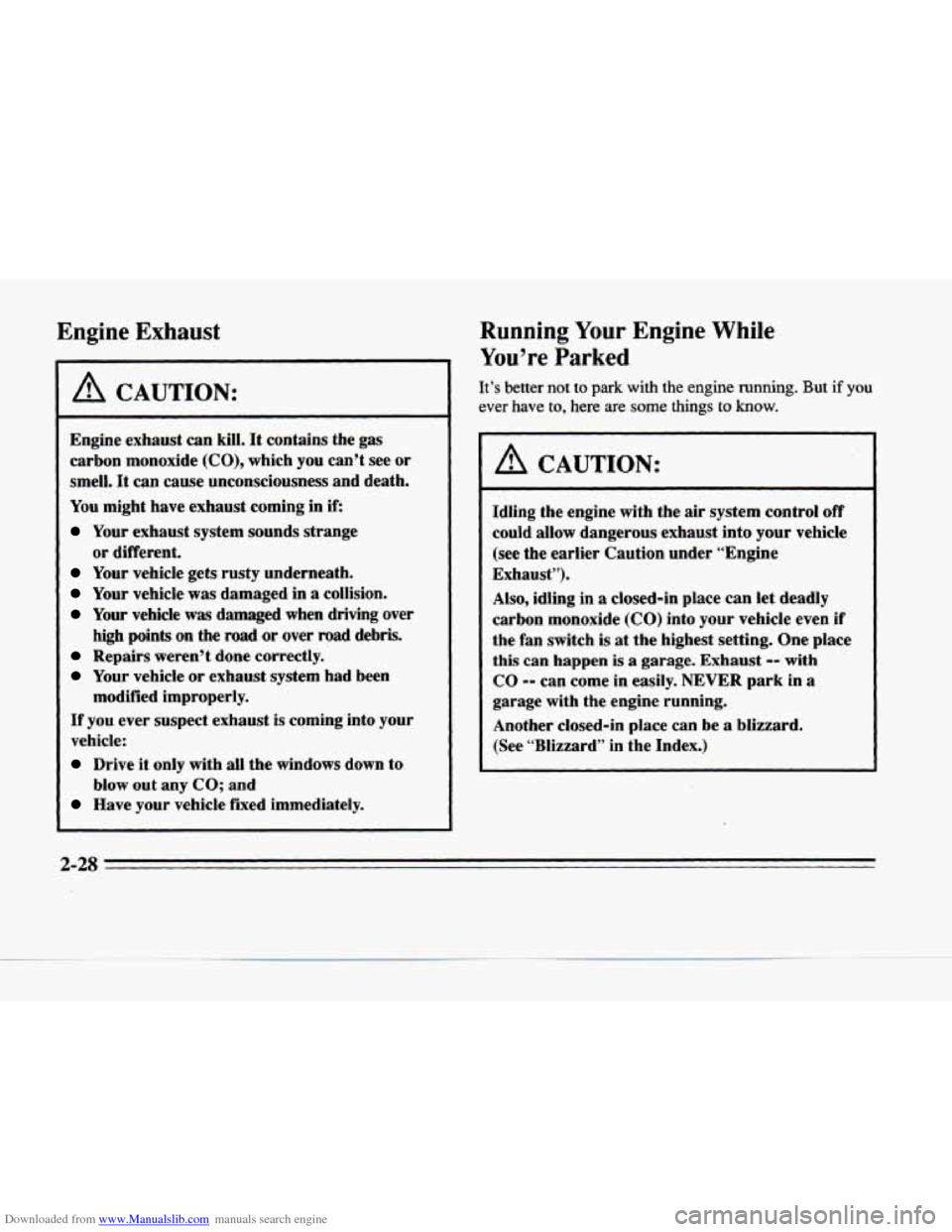
Downloaded from www.Manualslib.com manuals search engine Engine Exhaust
/r CAUTION:
Engine exhaust can kill. It contains the gas
carbon monoxide
(CO), which you can’t see or
smell.
It can cause unconsciousness and death.
You might have exhaust coming in
if:
Your exhaust system sounds strange
Your vehicle gets rusty underneath.
Your vehicle was damaged in a collision.
Your vehicle was damaged when driving over
high points on the road or over road debris.
Repairs weren’t done correctly.
Your vehicle or exhaust system had been
If you ever suspect exhaust is coming into your
vehicle:
Drive it only with all the windows down to
Have your vehicle fixed immediately.
or different.
modified improperly. blow out any
CO; and
Running Your Engine While
You’re Parked
It’s better not to park with the engine running. But if you
ever have to, here are some things to know.
A CAUTION:
Idling the engine with the air system control off
could allow dangerous exhaust into your vehicle
(see the earlier Caution under “Engine
Exhaust”).
Also, idling
in a closed-in place can let deadly
carbon monoxide
(CO) into your vehicle even if
the fan switch
is at the highest setting. One place
this can happen
is a garage. Exhaust -- with
CO -- can come in easily. NEVER park in a
garage with the engine running.
Another closed-in place can be
a blizzard.
(See “Blizzard’ in the Index.)
2-28
Page 92 of 354
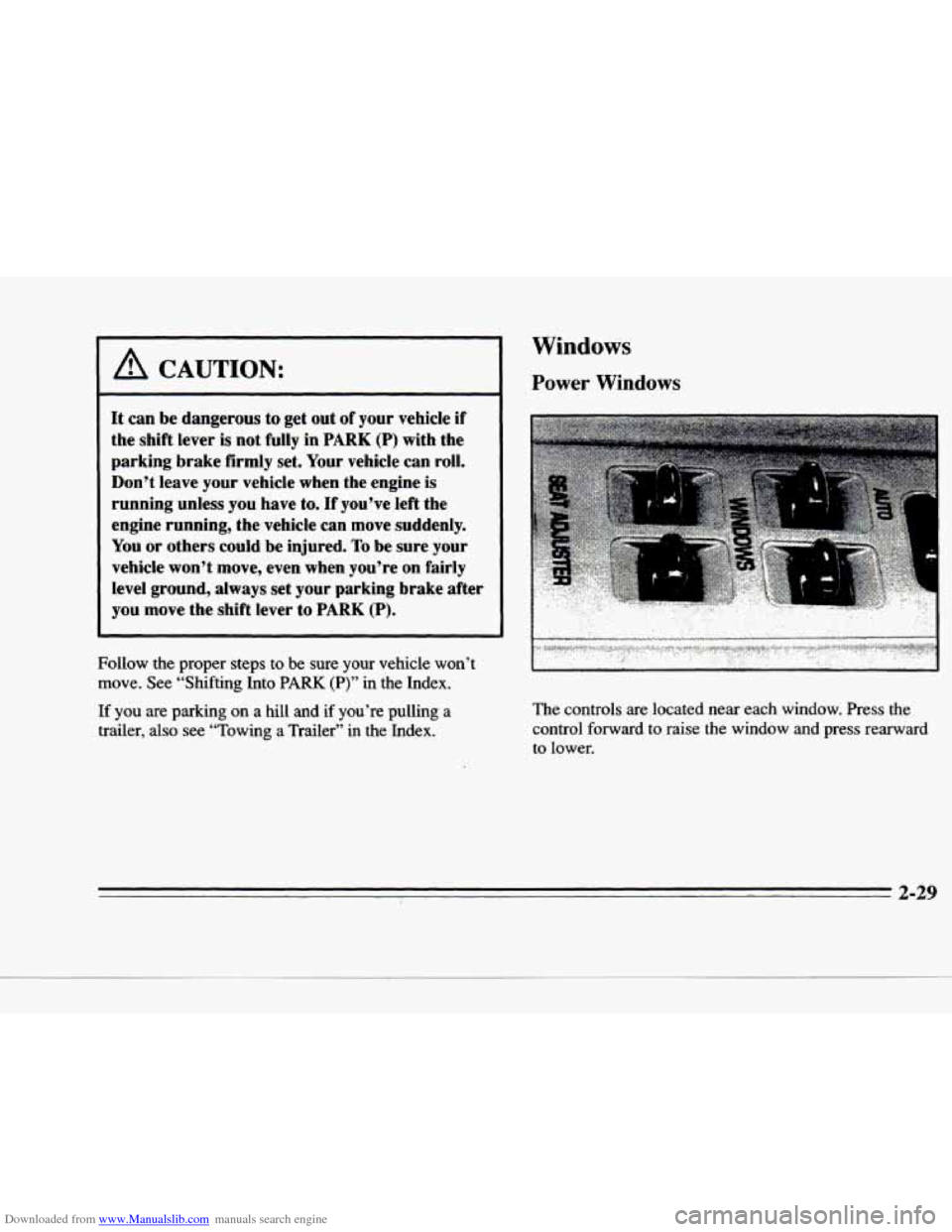
Downloaded from www.Manualslib.com manuals search engine p
I A CAUTION:
It can be dangerous to get out of your vehicle if
the shift lever is not fully in
PARK (P) with the
parking brake firmly set. Your vehicle
can roll,
Don’t leave your vehicle when the engine is
running unless you have to. If you’ve left the
engine running, the vehicle can move suddenly.
You or others could be injured, To be sure your
vehicle won’t move, even when you’re on
fairly
level ground, always set your parking brake after
you move
the shift lever to PARK (P).
c
Follow the proper steps to be sure your vehicle won’t
move. See “Shifting Into
PARK (P)” in the Index.
If
you are parking on a hill and if you’re pulling a
trailer, also see “Towing a Trailer” in the Index.
Windows
Power Windows
The controls are located near each window. Press the
control forward
to raise the window and press rearward
to lower.
c
Page 93 of 354
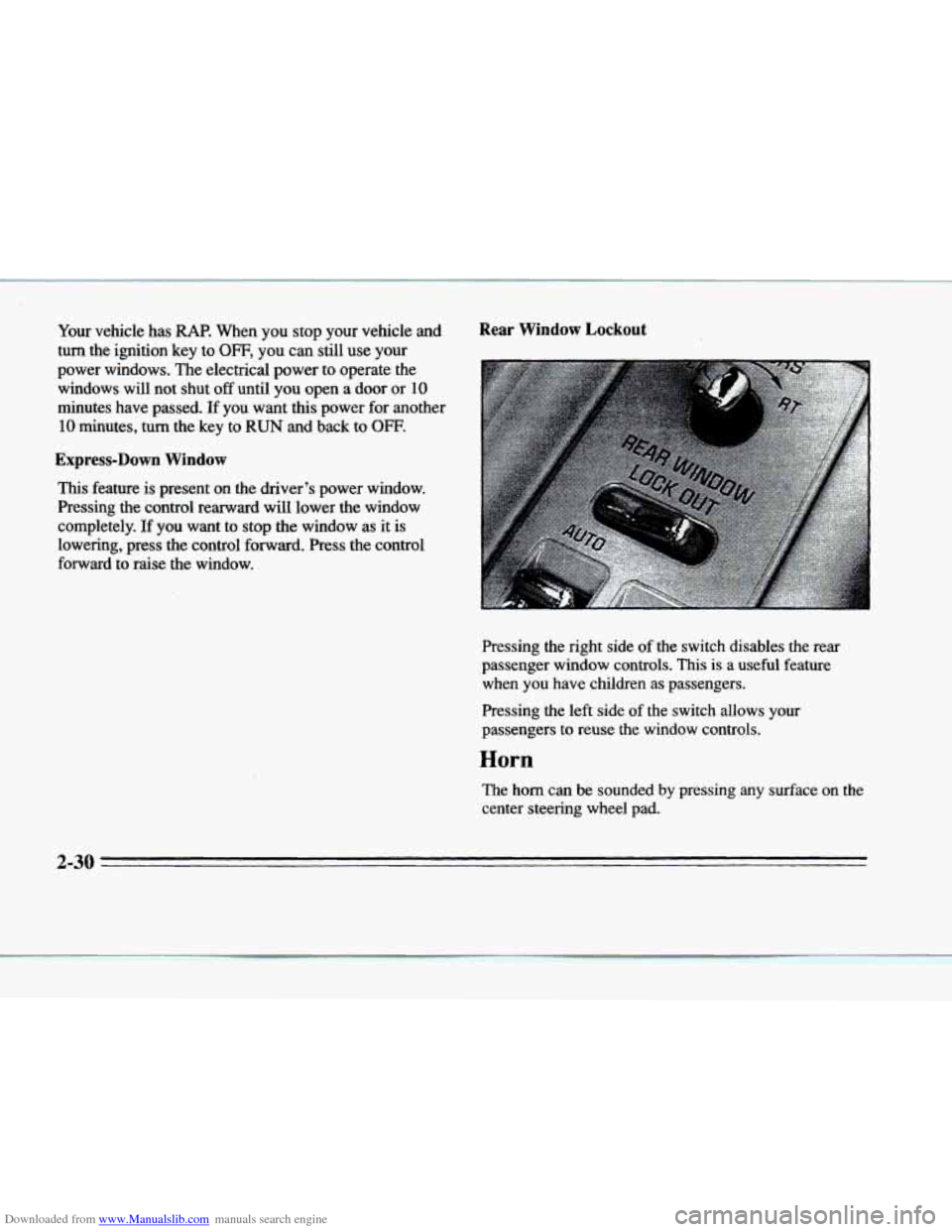
Downloaded from www.Manualslib.com manuals search engine Your vehicle has RAP. When you stop your vehicle and Rear Window Lockout
turn the ignition key to OFF, you can still use your
power windows. The electrical power to operate the
windows will not shut off until
you open a door or 10
minutes have passed. If you want this power for another
10 minutes, turn the key to RUN and back to OFF.
Express-Down Window
This feature is present on the driver’s power window.
Pressing the control rearward
will lower the window
completely.
If you want to stop the window as it is
lowering, press
the control forward. Press the control
forward to raise the window.
Pressing the right side
of the switch disables the rear
passenger window controls. This
is a useful feature
when you have children as passengers.
Pressing the
left side of the switch allows your
passengers to reuse the window controls.
Horn
The horn can be sounded by pressing any surface on the
center steering wheel pad.
2-30
Page 94 of 354
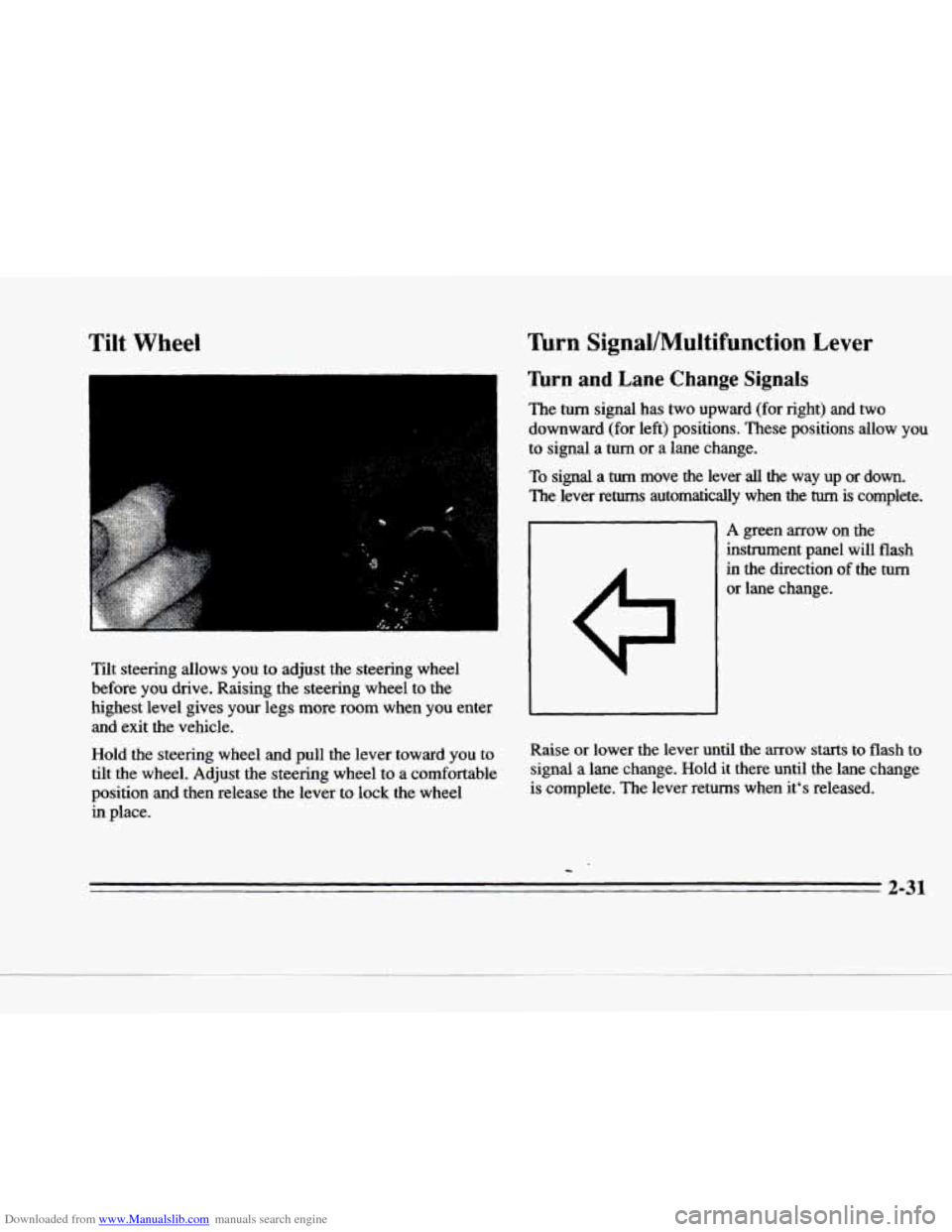
Downloaded from www.Manualslib.com manuals search engine Tilt Wheel
P
c
c
c
P
zit steering allows you to adjust the steering wheel
before you drive. Raising the steering wheel to the
highest level gives
your legs more room when you enter
and exit the vehicle.
Hold the steering wheel
and pull the lever toward you to
tilt the wheel. Adjust the steering wheel to a comfortable
position
and then release the lever to lock the wheel
in place.
Turn Signal/Multifunction Lever
lhrn and Lane Change Signals
The turn signal has two upward (for right) and two
downward (for left) positions.
These positions allow you
to signal a turn or a lane change.
To signal a turn move the lever all the way up or down.
The lever returns automatically when the turn is complete.
A green mow on the
instrument panel will
flash
in the direction of the turn
or lane change.
Raise or lower the lever until the
arrow starts to flash to
signal
a lane change. Hold it there until the lane change
is complete. The lever returns when it's released.
2-31
Page 95 of 354
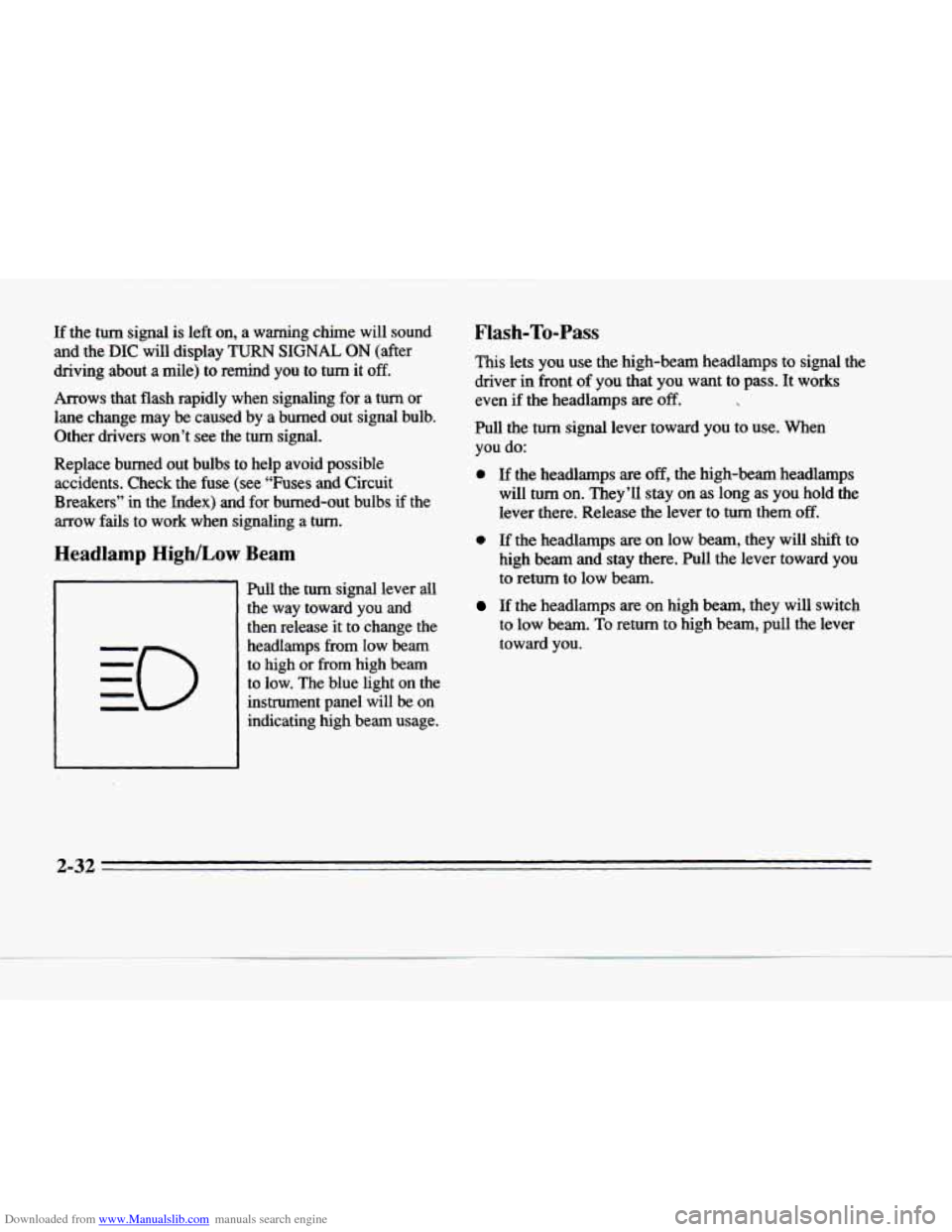
Downloaded from www.Manualslib.com manuals search engine If the turn signal is left on, a warning chime will sound
and the DIC
will display TURN SIGNAL ON (after
driving about
a mile) to remind you to turn it off.
Arrows that flash rapidly when signaling for a turn or
lane change may
be caused by a burned out signal bulb.
Other drivers won’t see the turn signal.
Replace burned out bulbs to help avoid possible accidents. Check the fuse (see “Fuses and Circuit
Breakers”
in the Index) and for burned-out bulbs if the
arrow fails to work when signaling a turn.
Headlamp High/Low Beam
Pull the turn signal lever all
the way toward you and then release
it to change the
headlamps
from low beam
to high
or from high beam
to low. The blue light on the
instrument panel will
be on
indicating high beam usage.
Flash-To-Pass
This lets you use the high-beam headlamps to signal the
driver in front
of you that you want to pass. It works
even
if the headlamps are ‘off.
Pull the turn signal lever toward you to use. When
you do:
0 If the headlamps are off, the high-beam headlamps
will turn
on. They’I1 stay on as long as you hold the
lever there. Release the lever to turn them
off.
0 If the headlamps are on low beam, they will shift to
high
beam and stay there. Pull the lever toward you
to return to low beam.
If the headlamps are on high beam, they will switch
to low beam. To return to high beam, pull the lever
toward you.
2-32
Page 96 of 354
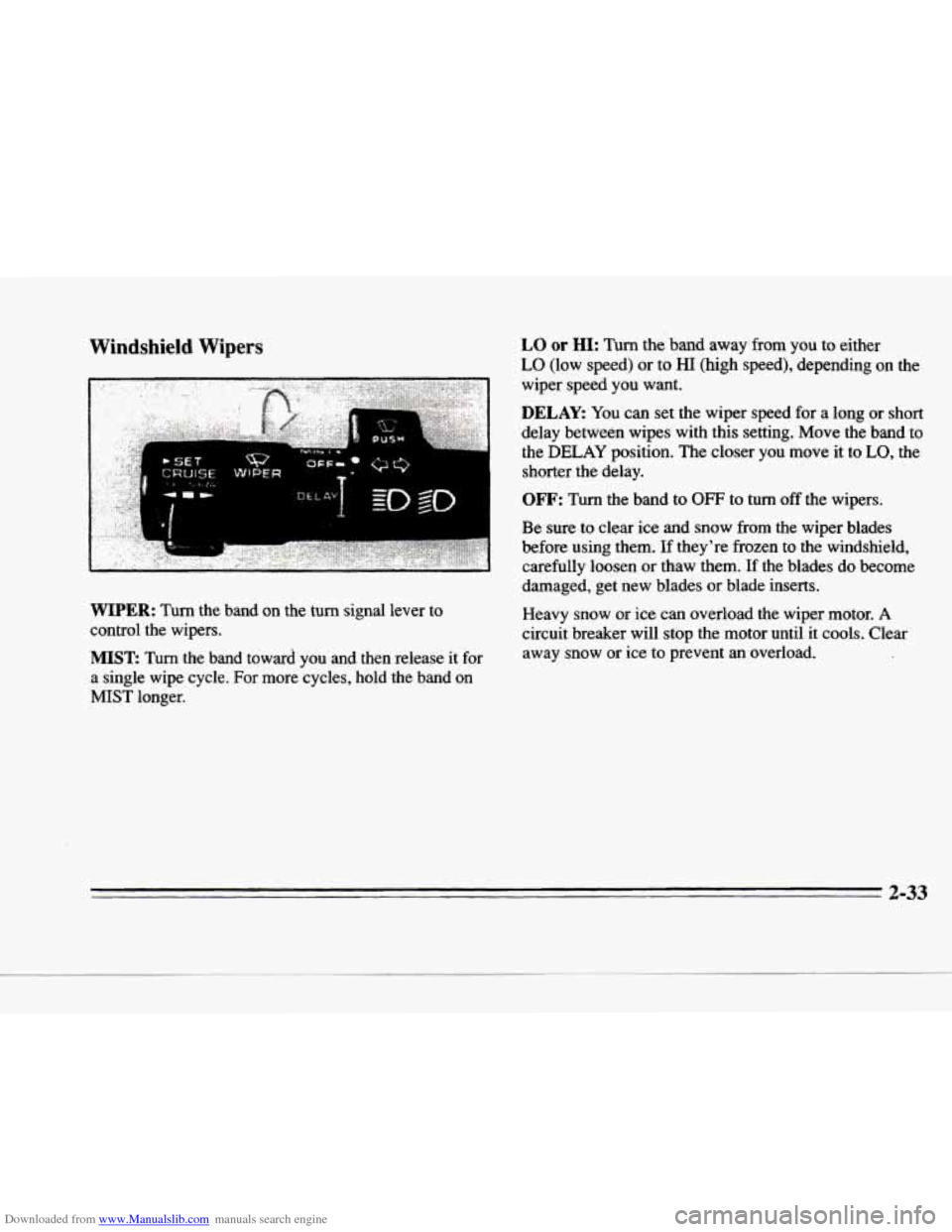
Downloaded from www.Manualslib.com manuals search engine c
c
e
c
Windshield WiDers
WIPER: Turn the band on the turn signal lever to
control the wipers.
MIST Turn the band toward you and then release it for
a single wipe cycle. For more cycles, hold the band on
MIST longer.
LO or HI: Turn the band away from you to either
LO (low speed) or to HI (high speed), depending on the
wiper speed
you want.
DELAY: You can set the wiper speed for a long or short
delay between wipes
with this setting. Move the band to
the
DELAY position. The closer you move it to LO, the
shorter the delay.
OFF: Turn the band to OFF to turn off the wipers.
Be sure to clear ice and snow from the wiper blades
before using them. If they’re frozen to the windshield,
carefully loosen
or thaw them. If the blades do become
damaged, get new blades
or blade inserts.
Heavy snow or ice can overload the wiper motor.
A
circuit breaker will stop the motor until it cools. Clear
away snow or ice to prevent
an overload.
2-33
Page 97 of 354
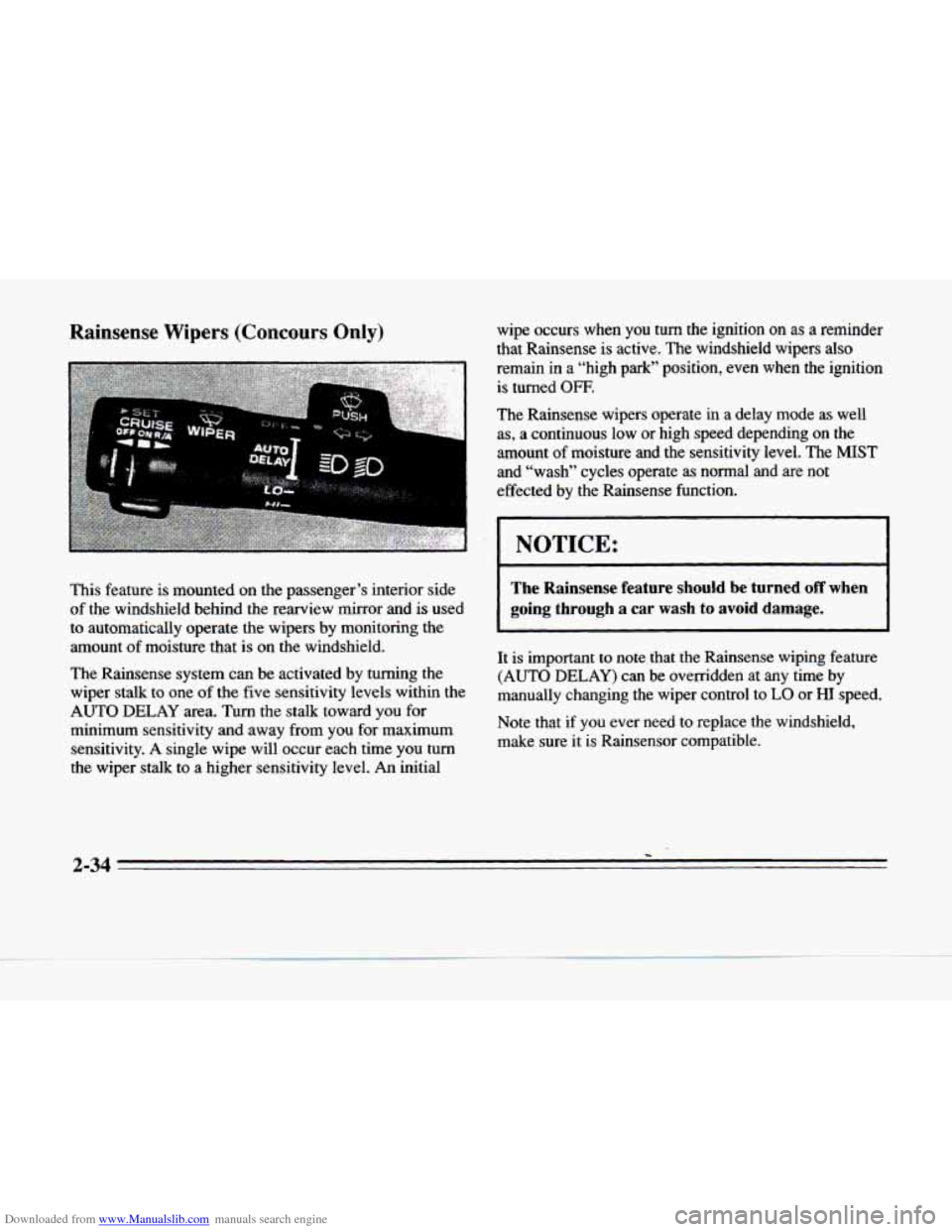
Downloaded from www.Manualslib.com manuals search engine This feature is mounted on the passenger’s interior side
of the windshield behind the rearview mirror and is used
to automatically operate the wipers by monitoring the
amount
of moisture that is on the windshield.
The Rainsense system can be activated by turning the
wiper stalk
to one of the five sensitivity levels within the
AUTO DELAY area. Turn the stalk toward you for
minimum sensitivity and away from you for maximum
sensitivity.
A single wipe will occur each time you turn
the wiper stalk to a higher sensitivity level.
An initial wipe occurs when
you turn the ignition on as a reminder
that Rainsense is active. The windshield wipers
also
remain in a “high park” position, even when the ignition
is turned
OFF.
The Rainsense wipers operate in a delay mode as well
as, a continuous low or high speed depending on the
amount
of moisture and the sensitivity level. The MIST
and “wash” cycles operate as normal and are not
effected by the Rainsense function.
NOTICE: I
- -- -~
The Rainsense feature should be turned off when
going through a car wash
to avoid damage.
It is important to note that the Rainsense wiping feature
(AUTO DELAY) can be overridden at any time
by
manually changing the wiper control to LO or HI speed.
Note that if you ever
need to replace the windshield,
make sure it is Rainsensor compatible.
2-34
-
Page 98 of 354
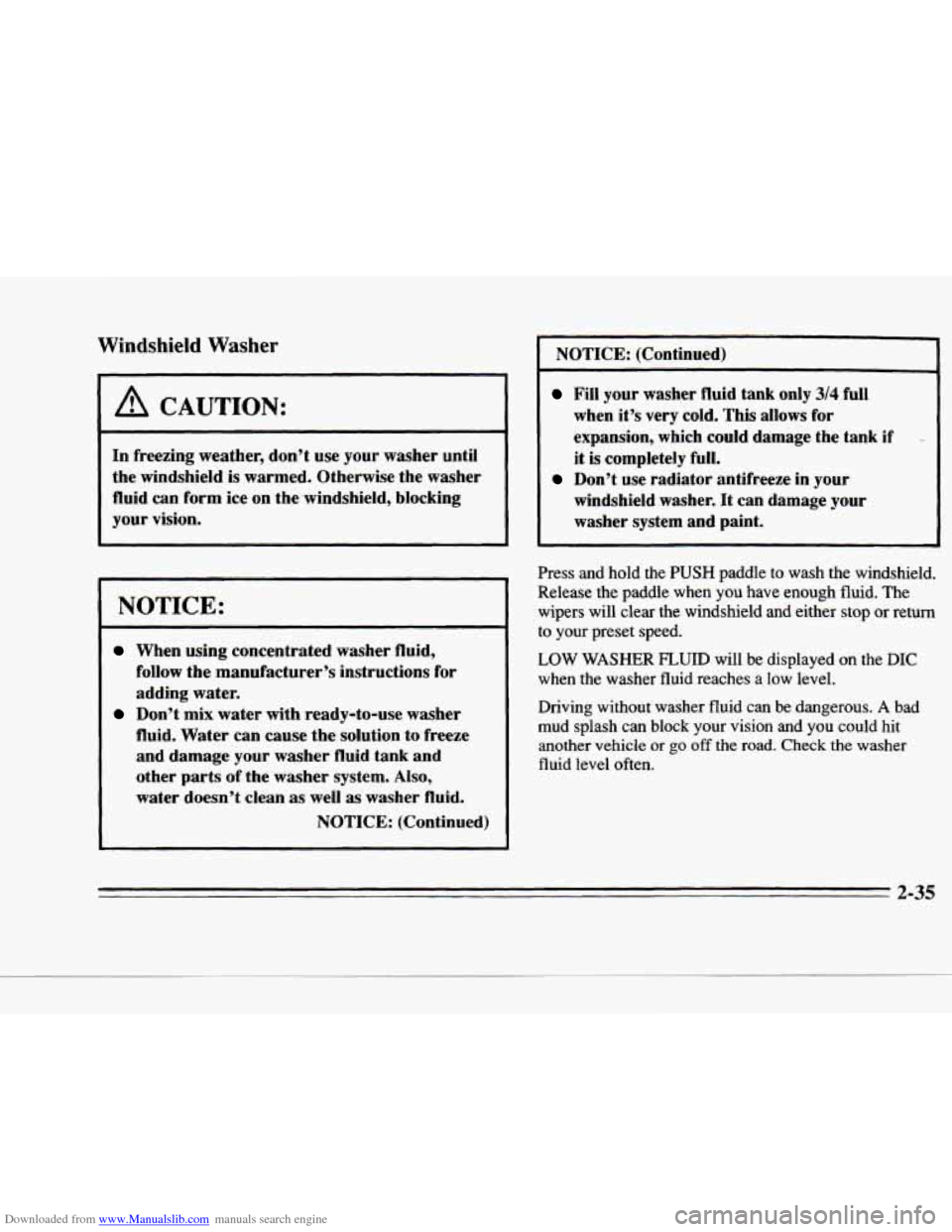
Downloaded from www.Manualslib.com manuals search engine P
P
c
Windshield Washer
A CAUTION:
In freezing weather, don’t use your washer until
the windshield
is warmed. Otherwise the washer
fluid can form ice on the windshield, blocking
your vision.
NOTICE:
When using concentrated washer fluid,
follow the manufacturer’s instructions for
adding water.
Don’t mix water with ready-to-use washer
fluid. Water can cause the solution to freeze
and damage your washer fluid tank and
other parts of the washer system.
Also,
water doesn’t clean as well as washer fluid.
NOTICE: (Continued)
NOTICE: (Continued)
Fill your washer fluid tank only 314 full
when
it’s very cold. This allows for
expansion, which could damage the tank
if
it is completely full.
windshield washer. It can damage your
washer system and paint.
Don’t use radiator antifreeze in your
Press and hold the
PUSH paddle to wash the windshield.
Release the paddle when you have enough fluid. The
wipers will
clear the windshield and either stop or return
to your preset speed.
LOW WASHER FLUID will be displayed on the DIC
when the washer fluid reaches a low level.
Driving without washer fluid can be dangerous.
A bad
mud splash
can block your vision and you could hit
another
vehicle or go off the road. Check the washer
fluid level often.
2-35 c
Page 99 of 354
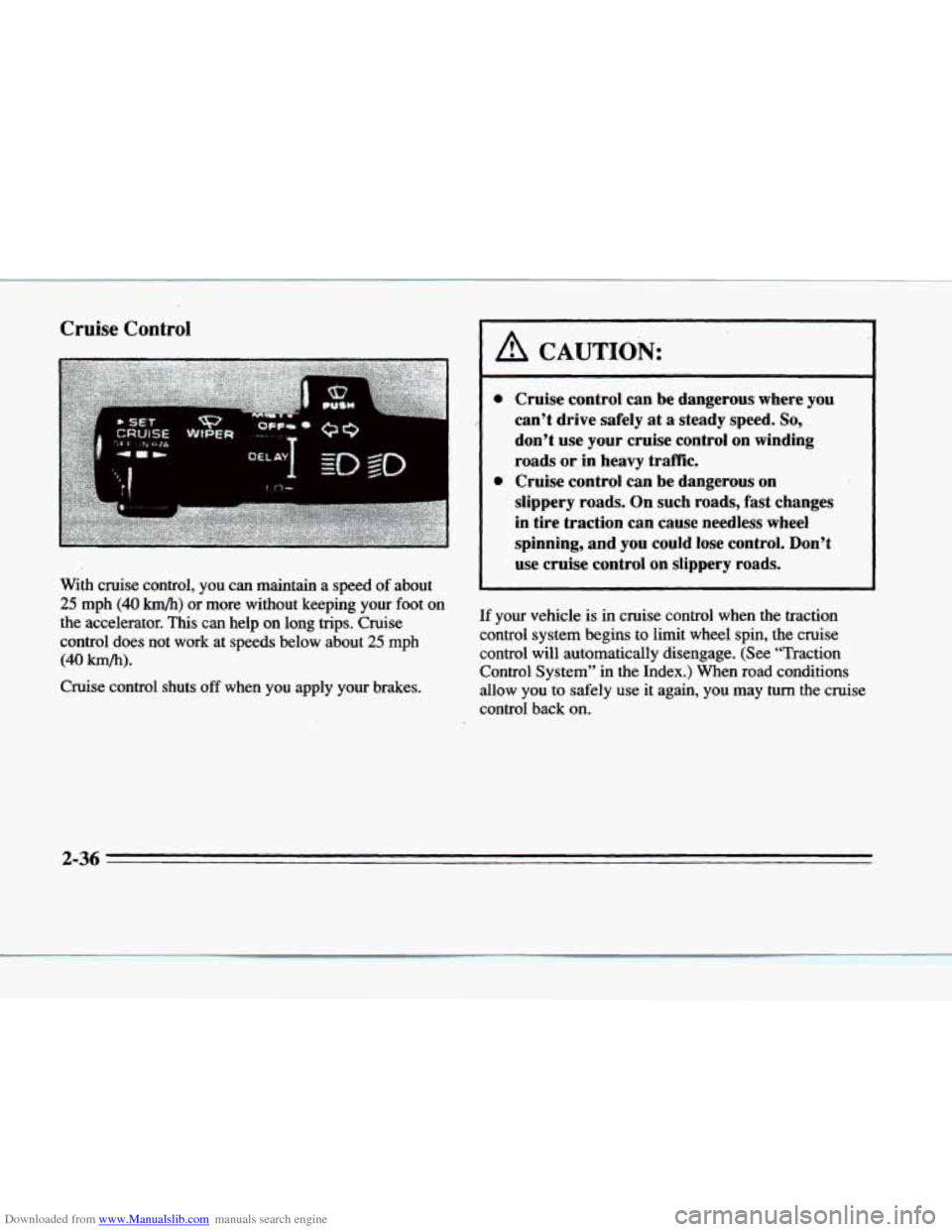
Downloaded from www.Manualslib.com manuals search engine Cruise Control
With cruise control, you can maintain a speed of about
25 mph (40 b/h) or more without keeping your foot on
the accelerator. This can help on long trips. Cruise
control does not work at speeds below about
25 mph
(40 km/h).
Cruise control shuts off when you apply your brakes.
A CAUTION:
e
e Cruise control can be dangerous where you
can’t drive safely at a steady speed.
So,
don’t use your cruise control on winding
roads
or in heavy traffic.
Cruise control can be dangerous on
slippery
roads. On such roads, fast changes
in tire traction can cause needless wheel
spinning, and
you could lose control. Don’t
use cruise control on slippery roads.
If your vehicle is in cruise control when the traction
control system begins
to limit wheel spin, the cruise
control will automatically disengage. (See “Traction Control System” in
the Index.) When road conditions
allow you to safely use it again, you may turn the cruise
control back on.
2-36
P
P
Page 100 of 354
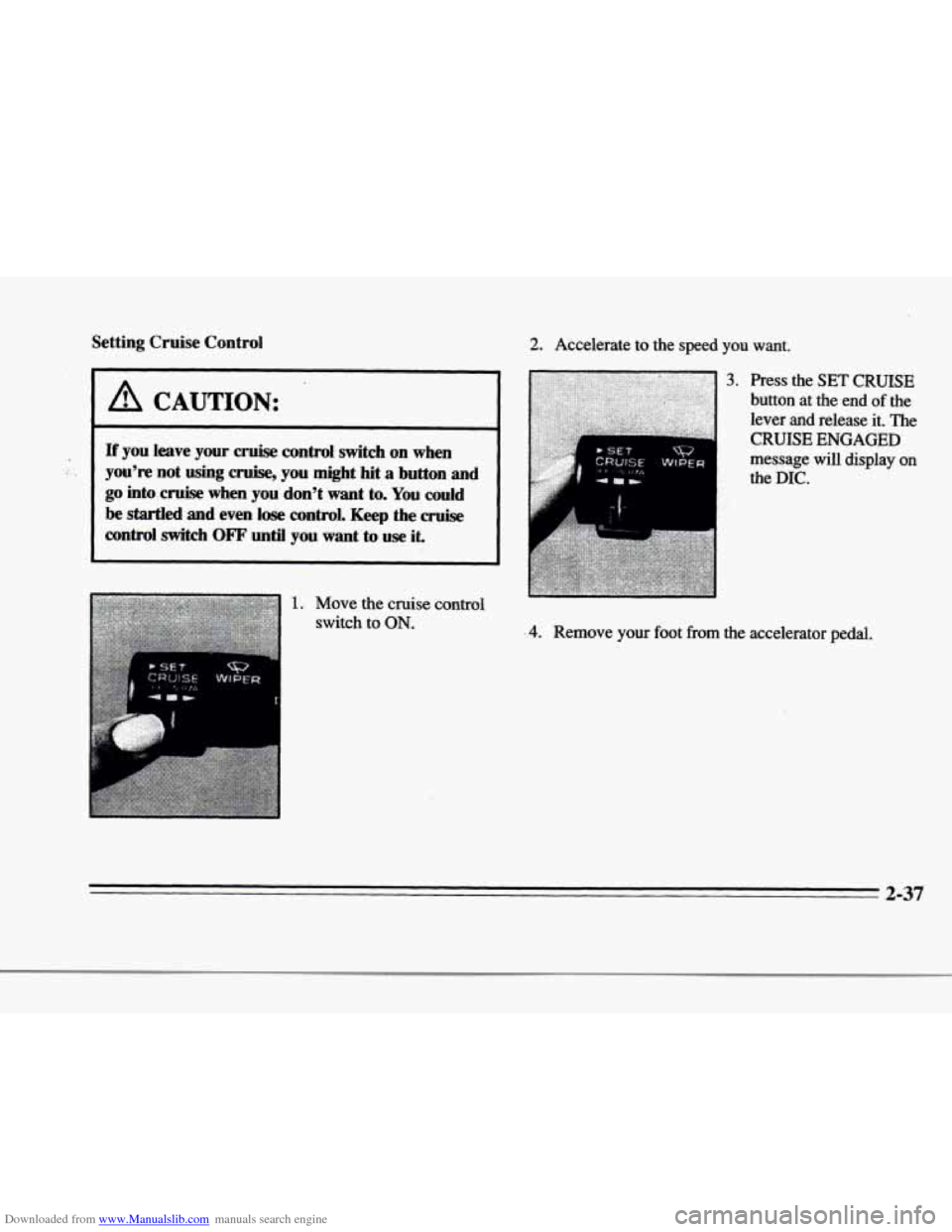
Downloaded from www.Manualslib.com manuals search engine r
r
r
r
r
r
r
r
" .
Setting Cruise Control
I A CAUTION:
A
If you leave your cruise control switch on when
you're not using cruise, you might hit a button and
go into.cruise when you don't want to. You could
be startied and even lose control. Keep the cruise
control switch OFF until you want to use it.
2. Accelerate to the speed you want.
1. Move the cruise control
switch to
ON. '4. Remove your foot from the accelerator pedal.
2-37